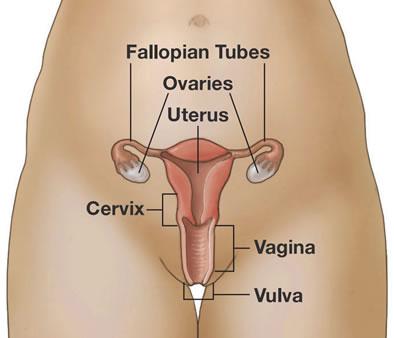The uterus is the medical term for the womb. It is the Latin word for womb. It is about the size and shape of an inverted pear. The uterus sits quite low in the abdomen and is held in position by muscles, ligaments and fibrous tissues. The uterus is joined to the vagina by the cervix that is also called the neck of the womb.

Uterus and periods
Each month in women of the reproductive age group the female body secretes hormones that causes ovulation (release of an egg from the ovary) and periods (menstruation). The lining of the uterus is called the endometrium. It is made of several layers that include surface epithelium, blood vessels, glands and other tissues.
Each month the endometrium grows thicker to prepare for pregnancy. This is synchronized with the ovulation. If a woman does not become pregnant, the top layers of the endometrium with blood from the blood vessels are shed. These flow out through the vagina in the monthly period. When a woman has her menopause the body stops production of hormones that cause ovulation and periods.
Functions of the uterus
Functions of the uterus include nurturing the fertilized ovum that develops into the fetus and holding it till the baby is mature enough for birth. The ferlized ovum gets implanted into the endometrium and derives nourishment from blood vessels which develop exclusively for this purpose. The fertilized ovum becomes an embryo, develops into a fetus and develops until childbirth.
The uterus provides structural integrity and support to the bladder, bowel, pelvic bones and organs as well. It separates the bladder and the bowels.
The networks of blood vessels and nerves of the uterus direct the blood flow to the pelvis and to the external genitalia, including the ovaries, vagina, labia, and clitoris for sexual response. The uterus is needed for uterine orgasm to occur.
Anatomy of the uterus
Uterus may be of several anatomical types. For example, some mammals like deer, moose, cats etc. have bipartite uterus, pigs and dogs have bicornuate uteri, single uterus with a single cavity is found in humans, horses and apes.
The uterus lies in the pelvis behind the urinary bladder and in front of the rectum. The uterus is a pear shaped muscular organ. It has four segments – the fundus (top of the uterus), corpus (body), cervix (mouth) and the internal os (opening).
The uterus has numerous nerves, and networks of arteries and veins as well as ligaments such as the round ligaments, cardinal ligaments, broad ligaments, and uterosacral ligaments of uterus.
| Name | From | To |
|---|---|---|
| uterosacral ligament | the posterior cervix | the sacrum of pelvis |
| cardinal ligaments | the side of the cervix | the ischial spines |
| ''pubocervical ligament'' | the side of the cervix | the pubic symphysis |
Diseases involving the uterus
There may be several pathologies and disease conditions involving the uterus. These include:
- Uterine prolapse
- Congenital abnormality of the uterus including congenital absence of the uterus Rokitansky Syndrome and others like Uterine Didelphys, bicornuate uterus and septate uterus
- Benign or non-malignant tumors of the uterus or uterine fibroids
- Adenomyosis
- Cervix cancer
- Cancer of the endometrium or uterine cancer
- Pyometra – infection of the uterus
- Adhesions within the uterus or Asherman's syndrome
Sources
- http://ep.physoc.org/content/92/4/621.full.pdf
- http://hersfoundation.com/anatomy/DVDText.pdf
- http://ror.reproduction-online.org/cgi/reprint/5/3/164
- http://abivf.com/challenges/inf-uterus/
- www.cancernz.org.nz/…/_ISCancerOfTheUterusJan11.pdf
Further Reading
- All Uterus Content
- Congenital Anomalies of the Uterus
- Retroverted Uterus (Tilted or Tipped Uterus)
Last Updated: Jun 28, 2019

Written by
Dr. Ananya Mandal
Dr. Ananya Mandal is a doctor by profession, lecturer by vocation and a medical writer by passion. She specialized in Clinical Pharmacology after her bachelor's (MBBS). For her, health communication is not just writing complicated reviews for professionals but making medical knowledge understandable and available to the general public as well.
Source: Read Full Article





